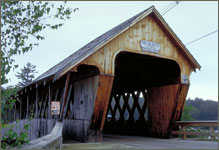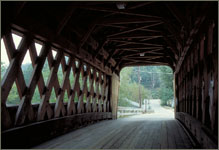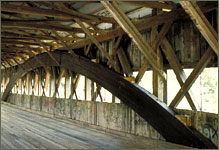Occupational Traditions – Covered Bridges
New Hampshire has a vast network of rivers and streams. In order to get anywhere quickly, you have to cross them, and for that you need bridges.

The Squam River covered bridge,
built by Milton Graton,
features a town lattice truss design
and a covered walkway.
The first long-span bridges were wooden. Made from available timber, such as spruce and white pine, the bridges were flexible and strong but decayed quickly when exposed to rain and snow. By the early 1800s, bridge builders began to protect their bridges with roofs and siding – making "covered bridges."
Of the many covered bridges that once existed in New Hampshire there are now 60, many of them built in the mid- to late 1800s and a few of them built in the last 20 years. The oldest covered bridge in the United States is the Haverhill-Bath Bridge, built in 1829. The longest is the Cornish-Windsor Bridge. It is 460 feet overall and crosses the Connecticut River with two clear spans.

The Squam River covered bridge,
built by Milton Graton,
features a town lattice truss design
and a covered walkway.
Covered bridges represent the birth of American engineering. Heavy timbers, spliced together with stress-bearing joinery, form the base and top of a wooden covered bridge. Builders found that a wooden bridge could span more than 200 feet if it was made of a series of triangular panels called trusses. Where these meet, interlocking joints are carefully fashioned and connected firmly with wooden pins called treenails or trunnels. Covered bridges are supported at the banks of a river or stream with stone abutments, themselves requiring enormous skill to design and build.
Some early bridgewrights invented truss designs of their own – Ithiel Town, Samuel Long, and William How patented trusses that still bear their names. New Hampshire bridgewright Peter Paddleford, from Littleton, invented the most complicated truss of all – the Paddleford truss. Other innovations included the laminated arch. First introduced by New England bridgewrights, these were often inserted in older bridges that needed strengthening.

The Albany covered bridge features
a long truss design that has been
strengthened with laminated arches.
Because covered bridges are beautiful marvels of engineering, some communities in New Hampshire choose to restore their bridges or to replace older ones that have been destroyed by accidents. In the 1930s Milton S. Graton pioneered the restoration of historic covered bridges and the building of new ones. His work took him around New England and as far west as Michigan. His descendents continue the work today. As interest in traditional timber framing has gained momentum, more builders and restorationists are becoming interested in preserving our covered bridge heritage.
The field of historic restoration is changing, however. Modern insurance and engineering requirements are making the work of repairing historic covered bridges and other structures more costly and complicated. Therefore, it is becoming more difficult for small-scale contractors to undertake this important work.

The underside of a covered bridge
reveals the sturdy
timber framed construction.
Special note: A 36-foot town lattice covered bridge was built for display at the 1999 Smithsonian Folklife Festival and 2000 Celebrate NH Festival. The wood donations and delivery services for it were coordinated by Sarah Smith of the University of New Hampshire Cooperative Extension Services and New Hampshire Division of Forests and Lands and provided by Timco, J.C. Eames Timber Harvesters, Dodge Lumber, International Paper-Madison Lumber Mill, Durgin and Crowell, Perras Lumber, and Gerrity Lumber, a subsidiary of Wickes Lumber. The bridge was purchased by Heritage New Hampshire, owned by Stoney Morrell.
For more information on covered bridges and traditional timber framing, visit these websites:
Photo credit: Lynn Martin Graton
New Hampshire State Council on the Arts
19 Pillsbury Street - 1st Floor, Concord, NH 03301


